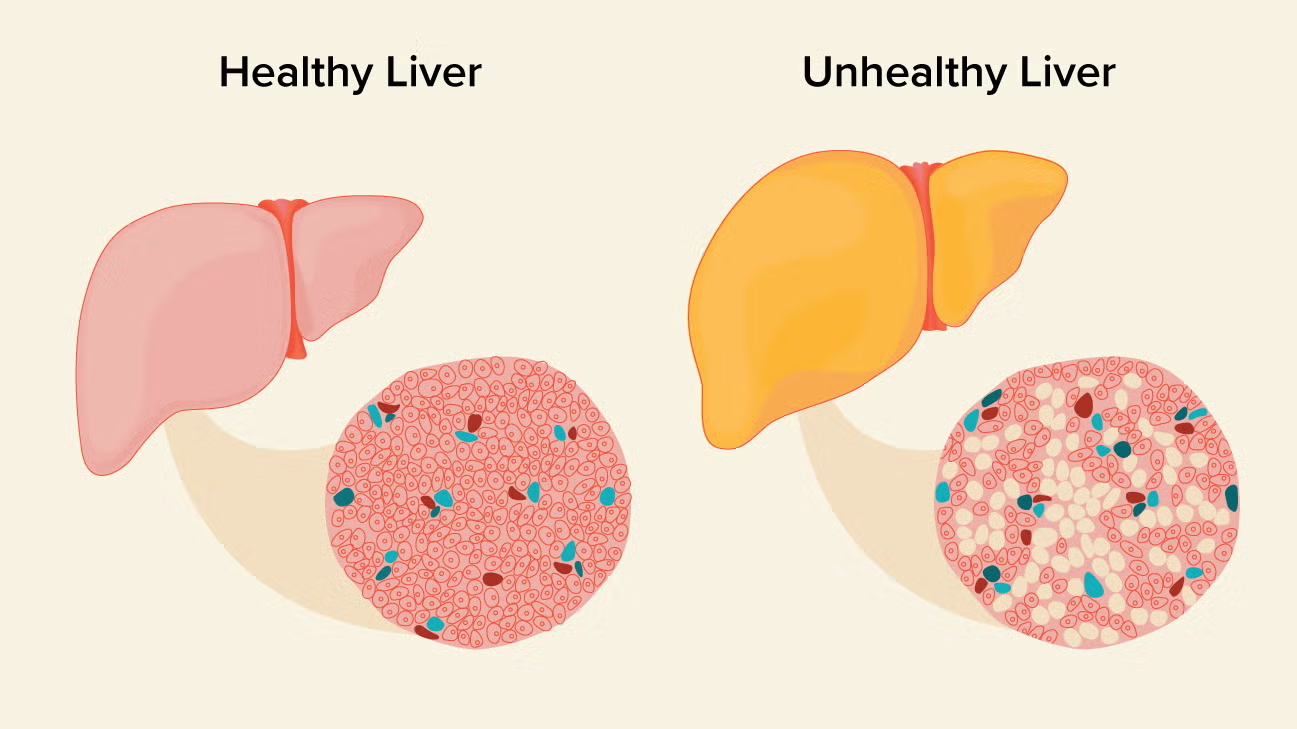
Fatty liver disease, a condition where excess fat accumulates in the liver cells, is becoming an increasingly prevalent health concern worldwide, and understanding its underlying causes, associated risks, and effective management strategies is crucial for maintaining overall well-being. Though often asymptomatic in its early stages, this condition can lead to severe liver damage if left unaddressed, highlighting the importance of early detection and proactive lifestyle changes to prevent progression.
What Exactly Is Fatty Liver Disease?
Fatty liver disease, medically known as hepatic steatosis, occurs when fat makes up more than 5-10% of your liver’s weight. The liver naturally contains some fat. However, when this level is exceeded, it can impair the liver’s normal functioning. There are two main types of fatty liver disease: alcoholic fatty liver disease (AFLD) and non-alcoholic fatty liver disease (NAFLD). AFLD is directly caused by excessive alcohol consumption, as alcohol damages liver cells and interferes with fat metabolism. NAFLD, on the other hand, develops in people who consume little to no alcohol. It is primarily linked to metabolic factors. This distinction is crucial for diagnosis and tailored management plans.
Causes of Non-Alcoholic Fatty Liver Disease (NAFLD)
NAFLD is the more common form of fatty liver disease globally and in the UAE. Its primary cause is generally linked to metabolic dysfunction. When the liver cannot process and break down fats as it should, excess fat accumulates. The most significant risk factors include obesity, especially when fat is centered around the waist. Type 2 diabetes is another major contributor, as insulin resistance often coexists with NAFLD. Other risk factors include high blood pressure, high cholesterol, and insulin resistance (a condition where your cells don’t respond well to insulin). Rapid weight loss can sometimes trigger or worsen NAFLD. Certain medications, though less common, can also contribute to fat accumulation in the liver. Genetics can also play a role, making some individuals more predisposed.
Risk Factors in the UAE
The prevalence of NAFLD is a growing concern in the United Arab Emirates, mirroring global trends. Studies indicate that a significant portion of the adult population in the UAE is at risk. For instance, some reports suggest that nearly 30% of the UAE’s adult population could be affected by NAFLD, with projections indicating an increase to 372,000 cases by 2030. This high prevalence is closely tied to the country’s high rates of obesity and type 2 diabetes. In the UAE, approximately 19.3% of the adult population is diabetic, and about half of all residents are overweight. These statistics highlight the urgent need for awareness and intervention strategies in the region. Metabolic syndrome, a cluster of conditions including increased blood pressure, high blood sugar, excess body fat around the waist, and abnormal cholesterol levels, also significantly increases the risk of NAFLD in the UAE population.
Causes of Alcoholic Fatty Liver Disease (AFLD)
As the name suggests, Alcoholic Fatty Liver Disease (AFLD) is caused by excessive alcohol consumption. Alcohol is directly toxic to liver cells. It interferes with the liver’s ability to metabolize fats efficiently. Even moderate drinking over time can lead to fat accumulation in the liver. However, heavy and prolonged alcohol abuse significantly increases the risk and severity of AFLD. The liver is the primary organ responsible for breaking down alcohol. When too much alcohol is consumed, the liver becomes overwhelmed. This leads to inflammation and fat buildup. It’s important to note that the amount of alcohol that causes damage varies among individuals. Even without apparent symptoms, continuous alcohol consumption can lead to more severe liver conditions.
Symptoms and Diagnosis
In its early stages, fatty liver disease often has no noticeable symptoms. This makes early detection challenging. It is frequently discovered incidentally during routine medical check-ups or tests for other conditions. As the disease progresses, some individuals might experience mild symptoms. These can include a dull or aching pain in the upper right side of the abdomen. Extreme tiredness and unexplained weakness are also possible. In more advanced stages, such as non-alcoholic steatohepatitis (NASH) or cirrhosis, symptoms become more pronounced. These might include yellowing of the skin and eyes (jaundice), itchy skin, and swelling in the legs, ankles, or abdomen. Diagnosis typically involves a physical examination. Blood tests check for elevated liver enzymes. Imaging techniques like ultrasound, CT scans, or MRI can confirm fat in the liver. A liver biopsy might be needed in some cases. This helps assess the extent of damage.
Management Strategies for NAFLD
The cornerstone of NAFLD management is lifestyle modification. Currently, there are no specific medications approved solely for NAFLD, although some are in advanced clinical trials. The primary goal is to reduce fat in the liver and prevent disease progression.
- Weight Loss: Losing even 5-10% of body weight can significantly reduce liver fat. A gradual and sustained weight loss is more effective and safer.
- Healthy Diet: Adopting a balanced diet rich in fruits, vegetables, whole grains, and lean proteins is crucial. Limiting processed foods, sugary drinks, and foods high in saturated and trans fats is essential. Reducing intake of refined carbohydrates and high-fructose corn syrup can also help.
- Regular Exercise: Aim for at least 150 minutes of moderate-intensity aerobic activity per week. This could include brisk walking, cycling, or swimming. Resistance training two to three times a week also helps. Exercise improves insulin sensitivity and helps burn liver fat, even without significant weight loss.
- Managing Underlying Conditions: Effectively managing conditions like type 2 diabetes, high blood pressure, and high cholesterol is vital. Working closely with your healthcare provider to control these comorbidities can prevent further liver damage.
- Avoid Alcohol: While NAFLD is non-alcoholic, abstaining from alcohol is still recommended. Alcohol can put additional stress on the liver and worsen the condition.
In the UAE, public health initiatives often emphasize these lifestyle changes. Doctors in Dubai, for example, typically advise patients on NAFLD diet protocols that align with these guidelines.
Management Strategies for AFLD
For Alcoholic Fatty Liver Disease (AFLD), the most critical step is complete alcohol cessation. Stopping alcohol intake can often reverse the fatty liver stage. However, if the disease has progressed to alcoholic hepatitis or cirrhosis, the damage might be irreversible. In addition to abstinence, management also involves:
- Nutritional Support: Many individuals with AFLD suffer from malnutrition. A balanced diet and vitamin supplementation are important.
- Managing Complications: If complications like fluid buildup in the abdomen (ascites) or bleeding from esophageal varices occur, specific medical interventions are needed.
- Support Groups: Seeking support from groups like Alcoholics Anonymous can be invaluable for maintaining sobriety.
Preventing Progression to More Severe Conditions
Early detection and aggressive management are key to preventing fatty liver disease from progressing to more severe conditions. If untreated, both NAFLD and AFLD can lead to non-alcoholic steatohepatitis (NASH), a more aggressive form characterized by inflammation and liver cell damage. NASH can then lead to fibrosis (scarring of the liver), which can advance to cirrhosis. Cirrhosis is irreversible scarring that impairs liver function. It can result in liver failure or hepatocellular carcinoma (HCC), a type of liver cancer. Regular follow-ups with a gastroenterologist or hepatologist are important to monitor liver health. Non-invasive tests like FibroScan can help assess liver stiffness and fibrosis progression.
The Role of Lifestyle in Prevention
Prevention is always better than cure, and this holds true for fatty liver disease. Maintaining a healthy body weight through a balanced diet and regular physical activity is the most effective preventive measure. Limiting sugary drinks, highly processed foods, and unhealthy fats can significantly reduce your risk. Avoiding excessive alcohol consumption is paramount for preventing AFLD. Regular medical check-ups, especially if you have risk factors like diabetes or obesity, can help detect the condition early. In the UAE, where a significant portion of the population is at risk, public health campaigns often highlight the importance of adopting healthy lifestyle habits to combat the rising incidence of fatty liver disease and its associated complications.
New Treatment Avenues
While lifestyle changes remain the primary treatment, research into pharmacological interventions for NAFLD/NASH is ongoing. Several drugs are in clinical trials targeting different pathways involved in the disease. These include agents that reduce liver fat, decrease inflammation, or prevent fibrosis. Some medications used for diabetes or obesity, such as GLP-1 receptor agonists (e.g., semaglutide, liraglutide) and pioglitazone, have shown promise in improving liver histology in patients with NASH. Bariatric surgery might be an option for individuals with severe obesity and NAFLD. These advancements offer hope for future treatment options, but for now, lifestyle modifications remain the most powerful tool in our arsenal against fatty liver disease.
